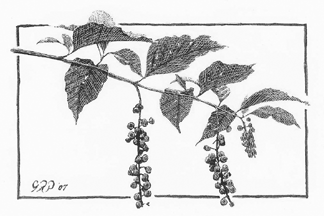|
|
 |
||||||||||
|
|||||||||||
|
|||||||||||
PokeweedElvis’s Poke Was Jefferson’s Ink BerryIn 1969, Elvis Presley heard a song called Poke Salad Annie. Elvis recorded the song and made it part of his live act. The King, who was born in a shotgun house in Tupelo, Miss., likely identified with the poor Southern girl portrayed in the song. He liked it so much that he recorded it three times, making it famous. The writer was Tony Joe White. Poke Salad Annie would go out every evening about suppertime, to pick a mess of pokeweed. She seemed to be all alone; “everybody said it was a shame that her Poppa was workin’ on a chain gang, or was it her Momma? But she got by.” She was “TCB.” That’s Elvis lingo for “taking care of business”. But don’t follow Annie’s lead and eat raw pokeweed, because it will put a hurtin’ on your belly. Phytolacea americana is a lush, fast-growing plant that favors areas of mixed sun and shade with rich, moist soils. This striking plant grows into one of our tallest, non-wetland, native plants. It can reach up to 10 feet on crimson stalks. The leaves are generally green but sometimes turn red. Their shape is simple and typically tropical in design: un-lobed and with a drip-point. Purple berries hang down in a spike. The juice of the pokeberry is blood red and toxic. Pokeweed has many other names, such as Ink Berry. The Declaration of Independence was written with ink made from fermented poke berry juice. Think about that the next time you bring out the Round Up spray. Various Native American tribes used pokeweed for a variety of medicinal purposes, according to Dr. Jim Duke in the Handbook of Northeastern Indian Medicinal Plants. Poke was applied to cuts or consumed for cramps, worms, cancer, fever and many more ailments. Poke is edible, but if not prepared properly it can be toxic. Avoid mature plants; young leaves make the best eating. Opinions differ on how to prepare it. I have eaten early spring poke leaves that were twice boiled, with the water changed for the second boil. For a gourmet twist, serve with clarified butter on whole-wheat toast points. Our pokeweed has a South American cousin that grows as a small tree. Called the ombu tree, it provides shade to the gauchos of the Argentinean pampas. In some parts of the world, our little poke is grown as an ornamental. Give it a little space and leave it alone; it will add a wild note in the garden. Elvis and Thomas Jefferson would both approve. Phytolacea americanaWhat to look for: Plants up to 10 feet tall with red stalks and prominent purple berries.Where to look: Roadsides; forest edges; overgrown, weedy areas. |
|||||||||||
|
|||||||||||
|
|
|||||||||||
|
© COPYRIGHT 2007 by New Bay Enterprises, Inc. All rights reserved. |
|||||||||||

